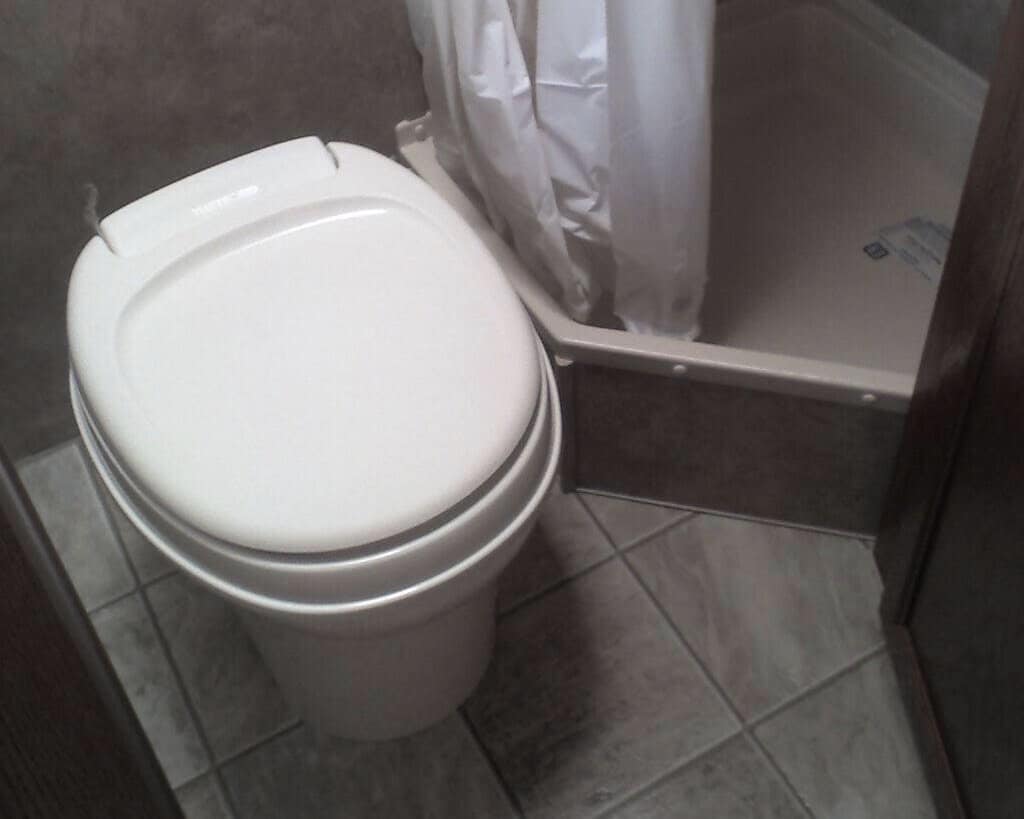There Are Some Interesting Kinds of RV Toilets
Toilets may not be your favorite topic of conversation, but it is something many RVers end up putting a lot of thought into. There are a number of different types of RV toilets out there. Depending on what kind of rig you own and how you camp, you may require a different RV toilet than the next guy.
If you’ve been considering changing your current RV toilet set up, you’re in the right place. This article will discuss everything you need to know about RV camper toilets (and maybe a little more).
Traditional RV Toilet
We’ll start with the traditional RV flush toilet. This is what comes standard in most RVs (although not necessarily camper vans or pop-up campers). It is connected to a water supply—either city water or pumped water from the fresh tank—which fills the bowl with water. The flush mechanism opens the bottom of the toilet, dropping the water and waste into a black tank where it is held until the tank is dumped.
Most of these traditional RV toilets come in a standard size, and the vast majority are made of plastic. That said, there are some exceptions.
Porcelain RV Toilet
If you hate sitting on a plastic toilet or can’t keep stains out of the bowl, a porcelain or ceramic RV toilet might be a good choice. These are more solid, easier to clean, and don’t tend to stain as easily.
Low Profile RV Toilet
If you’re putting a toilet into a tiny space or placing it on any kind of raised platform, a low-profile RV toilet might be necessary. These are smaller than standard-height toilets but perform the same job.
The biggest problems with a traditional RV toilet are freshwater usage, as well as black tank upkeep and smells.
Cassette Toilet for RV
Perfect for smaller rigs, the RV cassette toilet is another option. Most cassette toilets look and work pretty similar to other RV toilets. The one big difference? Instead of dumping into a black tank, they dump into a smaller waste tank (around 5 gallons of capacity), which is usually on wheels and can be detached and dumped at a public restroom or dump station.
The biggest con of this kind of toilet is the waste tank is so small, requiring more frequent dumping.
RV Composting Toilet
Ideal for those looking to save on water usage and/or get rid of their black tank, a composting toilet for RV campers is another great option. These toilets don’t use any water at all.
They work by sending “flushed” solid waste into a container of compost starter. The starter helps the waste decompose and create compost. Meanwhile, liquid waste is sent into a separate container, which can be dumped in a public bathroom, at a dump station, or in some cases, outside on the ground.
The major cons here are you need to empty the liquid tank often, compost can be a little bit icky, and there can be occasional smells from composting toilets (no worse than a black tank, though).
One of the most popular options in both the RV and marine space for a composting toilet is the OGO Compost Toilet. With its power agitation, patented urine diversion technology, built-in liquid Sensor and other available options, the OGO compost toilet is easy to use and easy to clean. No black tank is needed, has no odor, and chemical free.
RV Macerator Toilet
Also referred to as an electric RV toilet, the RV macerator toilet can be a good option for those who don’t like the idea of a cassette or composting toilet but often find themselves dealing with black tank problems. These toilets have a built-in macerating pump that grinds all waste into a liquid before pumping it into the black tank.
The black tank is completely sealed off when using one of these toilets, meaning fewer smells. Your toilet does not have to be located right over the tank. And the fact that all waste deposited into the tank as a liquid means no more clogs or buildup.
The biggest cons of a macerator toilet are that it requires electricity to run and uses a lot of extra water. This makes boondocking nearly impossible.
Another option is using a macerator pump outside of the RV. This allows you to dump using only a small hose. It also gives you the option to use a longer hose without issue and even dump uphill.
Incinerator Toilet for RV
A super fancy option for the avid boondocker, we must mention the RV incinerator toilet. These compact toilets are completely waterless and, as the name suggests, they actually incinerate your solid waste. They do this by using gas or electric heat, a process that can take anywhere from 30 minutes to 4 hours. There is little to no smell during this time, and disposal is easy and not gross at all.
A problem with this type of toilet is that you need to replace the bowl liner between uses. Additionally, some incinerator toilets require users to wait to use the restroom while incineration is in progress, meaning you might be left waiting for a while.
Portable RV Toilet
If your RV didn’t come equipped with a bathroom, or if you’re doing your own van build, you may be looking for simpler toilet options that don’t require plumbing. In this case, a portable RV toilet is your best bet.
A portable RV toilet works very much like a cassette toilet, dumping waste into a small tank that can be dumped in a toilet or dump station. Most models use fresh water that is stored in a special tank to flush. The only real difference? The toilet is not bolted down or connected to RV plumbing, meaning it is 100% portable.
The cons of a portable toilet? The tank is very small, as is the toilet itself. This means more dumping and a less pleasant bathroom experience.
Conclusion
With so many different types of RV toilets to choose from, we’re certain you’ll find the best option for you. Have you tried an incinerator toilet or other unique type listed above? Tell us your thoughts in the comments.






You forgot the no-flush Laveo toilet. I use one in my trailer and love it for its efficiency, lack of smell and ease of use. No more black water tank needed so I converted my black to a gray water and now have double the gray water capacity. 90 gals! You do need to buy replacement disposable cartridges but much much better than all the black tank maintenance and cost and no more dealing with yucky black tank issues. No propane needed just a battery to charge every few weeks which I now have hooked up to a solar charger made by laveo so no worries at all about recharging battery. Best bondocking toilet by far imo. Best toilet I have owned in 40 years of RV use.
What about the dreaded vacuum flush toilet?
The book Humanure contains all the info you need to make a composting toilet, for a very low price, but a whole lot more info. Shop around and you can get a copy for around $5. For around $10 I got a toilet seat, and a 5 gallon bucket. And you do NOT need to have a urine diverter, the book explains. This is what is going in my van when the conversion is complete – it will look just like a large chair, until you lift the chair seat. I have seen them in foot stools too. That way you can shift them around of you want, and have some extra space available. Basically it is a very inexpensive version of the expensive models, but no power needed, just trash bags and sawdust, pet betting, peat moss, or something else to cover the contents each time. And no moving parts to break, or power needed. I love to do with K.I.S.S. builds when I can (for the uneducated that translates as Keep It Simple Stupid).
I replaced the stinky marine toilet in our camper van with one I made with plywood box, urine diverted, 1 gallon jug, plastic bucket, and toilet seat. #1 goes into jug and is emptied daily. #2 goes in biodegradable bag inside bucket with woodchips or kitty litter and is disposed Smythe same place the grandkids pampers and bagged dog litter goes. All are mammals..no black tank. Works like a charm..No smell.